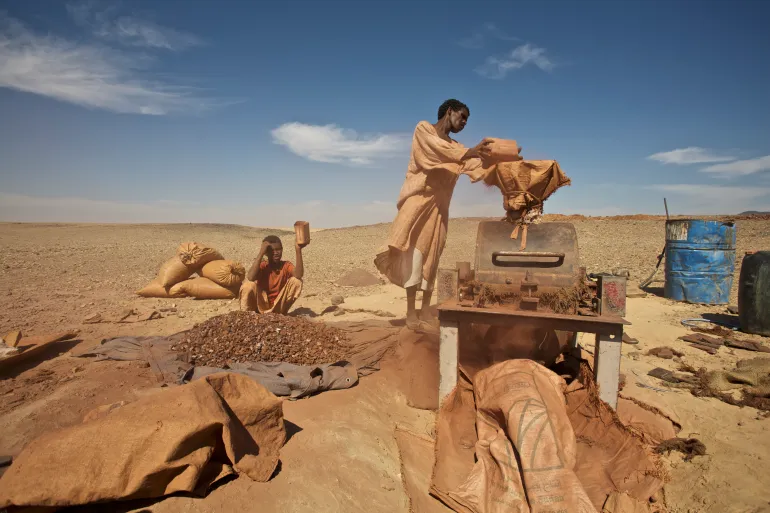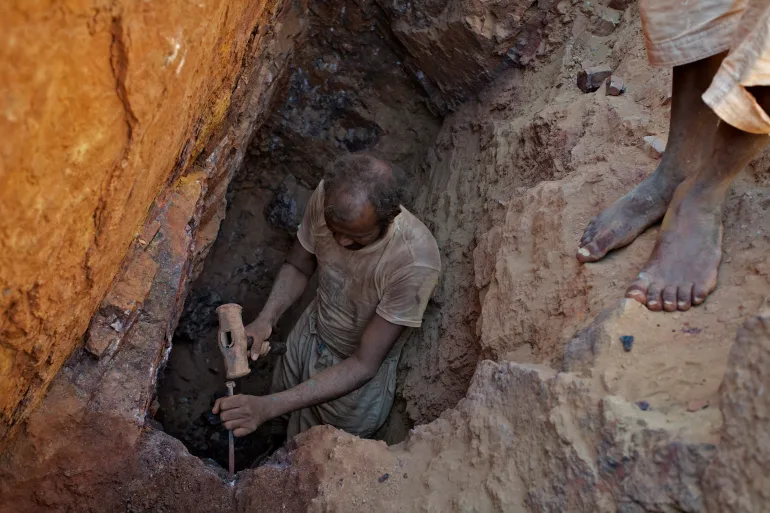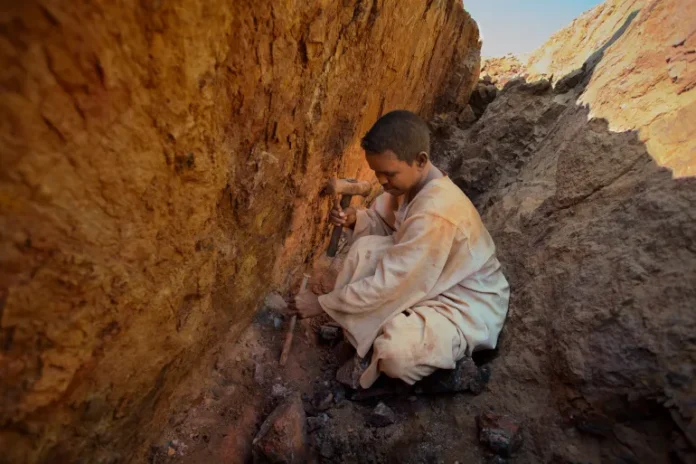Sudan is a prominent African country rich in mineral resources, especially gold, with over 40,000 sites dedicated to its mining. About 60 gold refining companies operate across 13 states, including 15 companies concentrated in South Kordofan state alone.
The desert regions of northern Sudan are considered the country’s richest in gold, containing huge reserves of the raw mineral. Gold is also found in multiple locations stretching from the far north near the capital Khartoum, through the eastern coast overlooking the Red Sea and the Red Sea mountain range, to the far west at Jebel Uweinat and the Tina area in the Darfur region.
Sudan relies on gold as a major source of foreign exchange, after losing three-quarters of its oil revenues due to the secession of South Sudan in July 2011, and losing 80% of foreign exchange resources, especially since oil revenues accounted for more than 50% of government revenues until the secession.
Production Volume

Sudan ranks third in Africa in gold production, with a production volume of about 18.6 million grams in 2022, a slight increase compared to 2019.
Sudan produced about 93 tons of gold in 2018, a level that makes it the third largest producer in the continent after South Africa and Ghana, according to a US geological survey.
According to estimates by the Sudanese Ministry of Energy and Mining, the country’s gold reserves amount to about 1,550 tons, according to what Anadolu Agency reported in October 2019.
Sudan has granted licenses to more than 85 companies to explore for and produce gold, as part of its efforts to enhance its production of minerals to obtain new sources of state revenues and foreign exchange to finance imports.

Prominent Major Mines in Sudan
Hassai Mine
The “Hassai” mine is one of the most prominent gold production sites in northeastern Sudan, and is considered the only operating mine in this mineral-rich region. It was discovered in 1993, and since then until 2011, its total production has amounted to about 2.3 million ounces of gold, extracted from about 18 open pits.
The mine is located about 50 kilometers from Khartoum, and is owned by two companies: the Sudanese “Ariab Mining Company,” which owns 60% of the share, and the “La Mancha Resources” company owned by the Egyptian businessman Naguib Sawiris, which owns the remaining 40%.
The proven and probable reserves in the mine are estimated at about 14.09 million tons, with a concentration rate of 2.4 grams of gold per ton. The “measured and indicated resources” are estimated at 16.06 million tons at a rate of 2.77 grams/ton, while the inferred resources reach 4.3 million tons at the same concentration rate.
The gold deposits in the Hassai mine are located within the “Ariab Green Belt” belonging to the Proterozoic era, and its geology is characterized by complex rock formations that include basic and acidic volcanic rocks, volcanic effusions, in addition to graywacke rocks. These formations have been subjected to intrusions from late granite rocks, reflecting a fertile geological structure for precious metals.
Block 15
The “Qabaqba” area, located north of the city of Abu Hamad in the River Nile State, is one of the most prominent gold mining areas in Sudan, and tops the list of production through artisanal (traditional) mining, which is the main source of gold in this region, and the first through artisanal mining in the country.
In March 2021, the “Managem Moroccan Mining Company” announced its acquisition of 65% of the Qabaqba mine expansion projects, after completing a strategic deal with the “Wanbao Chinese Mining Company.”
The company expected the expansion to cost about $250 million, with the aim of increasing the mine’s production capacity to about 200,000 ounces of gold annually.
The Moroccan company announced that this deal came within a strategic plan aimed at expanding its presence in Sudan and the African continent in general.
In “Block 15,” the “Managem” group, in cooperation with “Noreen Mining,” began implementing an intensive and continuous exploration program since 2008, which led to the discovery of gold deposits classified as world-class.
In 2011, the company established an integrated production unit in the region, supervised by its subsidiary “Manub,” and the strong operational performance, along with the new discoveries, contributed to expanding production operations and building a modern processing plant that complies with international standards, which enhanced the mine’s position as a strategic and promising project in the Sudanese mining industry.
“Managem Moroccan” is active in several countries, including the Democratic Republic of Congo, Ethiopia, Gabon, Guinea Conakry, Ivory Coast, and Mali, in addition to its operations in Morocco. The company is one of the oldest players in the mining sector, as it was founded in 1930, and has been listed on the Casablanca Stock Exchange since July 2000.
The gold projects managed by the company in Sudan are located on the border with Egypt, within the “Kiraaf Fault” area, known for its abundant gold production since Pharaonic times.
The three mineral blocks included in the exploration operations extend over a total area estimated at 14,479 square kilometers, with a length of approximately 300 kilometers, and include several geological corridors rich in gold.
Jebel Amer Mine
The mine is located in the Al-Siref locality, which is 100 kilometers north of the city of Al-Fasher in North Darfur State, and its production is estimated at about 50 tons of gold annually, according to Reuters, making it the third largest gold mine in Africa. The area also includes other precious metals, such as aluminum, iron, and platinum.
After the secession of South Sudan in 2011 and Sudan’s loss of about 75% of its oil resources, it began searching for economic alternatives, and gold was the most suitable and closest option.
Itinerant miners discovered huge quantities of gold in the hills of Jebel Amer in April 2012, and the news quickly spread, turning the area into a destination for wealth seekers from inside and outside Sudan, including arrivals from Chad, Niger, Mali, Nigeria, and Central Africa.
In a short time, the area became the most expensive natural resource in Sudan, and legends spread around it, because of its brilliance that appears with sunrise and sunset, until a mine in it was called “Switzerland” to indicate its richness in gold, which gave it a semi-mythical character.
This discovery led to the transformation of the Jebel Amer area into a theater for armed conflict. The “Janjaweed” militias, led by Musa Hilal, seized the mines after bloody battles with the Beni Hussein tribe, the original inhabitants of the area.
Hilal refused to hand over his weapons to the government of Omar al-Bashir, so he was arrested by the Rapid Support Forces, led by Mohamed Hamdan Dagalo (Hemedti), which took control of the area and the mines.
By 2017, the face of the conflict in Darfur had changed radically, as it was no longer limited to the political or ethnic dimension, but had become centered around the control of natural resources, foremost of which were gold mines. A new map of influence emerged, shared by the Rapid Support Forces on the one hand, and Russian networks such as the Wagner Group on the other, in an economic equation that increased the complexity of the local crisis.
Following the control of the Rapid Support Forces, the Al-Junaid Company, owned by Abdul Rahim Hamdan Dagalo, Hemedti’s brother, managed gold extraction operations in Jebel Amer. According to investigations conducted by Reuters, the company sometimes sold gold outside official channels, and sometimes to the Central Bank at preferential prices, which enabled the Rapid Support Forces to build a source of funding independent of the government.
Reports indicate that Al-Junaid was producing between 30 to 40 kilograms of gold per month, knowing that the company denies any connection with the Rapid Support Forces and confirms its independence.
The exploitation of gold led to the consolidation of the political and military influence of Hemedti, who quickly rose to become Vice President of the Sovereign Council after the ouster of Al-Bashir in 2019. The Rapid Support Forces gained financial and military independence, which it later used to strengthen its power internally and externally.
In this context, the “Meroe Gold” company, affiliated with the Russian Wagner Group, emerged and was established to take over gold exploration operations in Sudan, in cooperation with the Sudanese military intelligence. This company began its activities in Darfur, especially in rich areas such as Jebel Amer.
In January 2021, Al-Junaid Company announced the handover of the Jebel Amer mines to the transitional government headed by Abdullah Hamdok, after waiving the remaining certification in favor of the state.
The government considered this step an achievement towards regaining control over strategic resources, but the reality on the ground was different, as the Rapid Support Forces and the Al-Junaid Company maintained indirect influence in the region.
In October 2021, what was known as the “Dismantling Empowerment Committee” was dissolved. This body was pursuing the assets of companies linked to corruption and exploitation, including “Meroe Gold,” which the committee was trying to prevent from restructuring itself into a local company under the name “Al-Sulaj.”
Block 14 Mine
The Meias Sand Gold Project is located in the Nubian Desert in northern Sudan, near the Egyptian border, about 900 kilometers from Khartoum, and covers an area of approximately 2,170 square kilometers within what is known as Square 14.
This project is being developed through a partnership between the Australian “Perseus Mining Company” (which owns 70% of the share), the government of Sudan (20%), along with a local Sudanese company called “Meias Nub” which owns 10% of the project.
Exploration work is being carried out within the scope of the Arabian-Nubian Shield, where the geological formations vary between the andesitic volcanic “Jabqaba” topography in the east, and marine sediments belonging to the Kiraaf Fault in the west, separated by the “Eastern Jabqaba” Fault.
The project dates back to 2012, when the Canadian “Orca Gold” company signed a partnership agreement with “Meias Nub” and launched an intensive drilling program after an initial discovery in the “South Galat Sofar” deposit. Later, in 2015, the project expanded to include a new deposit in “Wadi Doum.”
In 2016, the initial economic assessment was issued, followed by the discovery of a strategic water resource in 2017, which confirmed the possibility of operating the project in a harsh desert environment.
In November 2018, the feasibility study for the project was completed, and the mineral reserve was estimated at 79.94 million tons with a concentration of 1.11 grams/ton, equivalent to 2.85 million ounces of gold.
“Orca Gold” was acquired by the Australian “Perseus Mining” in 2022, which allocated additional funding to update the estimates and implement the “FFED” (Front End Engineering Design) study in 2023, in a step that paves the way for taking the final investment decision.
Songo Mines
The Songo mines are located in the Al-Radoum area in South Darfur State, 360 kilometers south of Nyala. Since 2016, it has become an active center for artisanal mining, after being a remote and sparsely populated area. Al-Radoum is classified as one of the richest areas in South Darfur in gold, and witnesses frequent movements of thousands of traders, soldiers, and local workers.
Before the outbreak of the Sudanese war, the Songo area was bustling with activity, as about 100,000 miners worked in prominent sites, such as Agbash, Daraba, Thuraya, Wadi Nyala, Sarfaya, and Jomana. However, the conflict and security breakdown led to an almost complete halt to mining in 2023, especially with the interruption of fuel supplies, and many workers joined the Rapid Support Forces.
Al-Junaid Company is the only active operator in the region. Its operations have witnessed a sharp decline due to fuel shortages, which forced it to reduce its workforce by 70%, reducing monthly production to less than a ton of gold.
But by October 2023, and with the end of the rainy season, operations were resumed rapidly, and the area became again one of the active sources of labor, despite the continued security threats.
Source: Al-Yura + Al-Jazeera + Reuters


